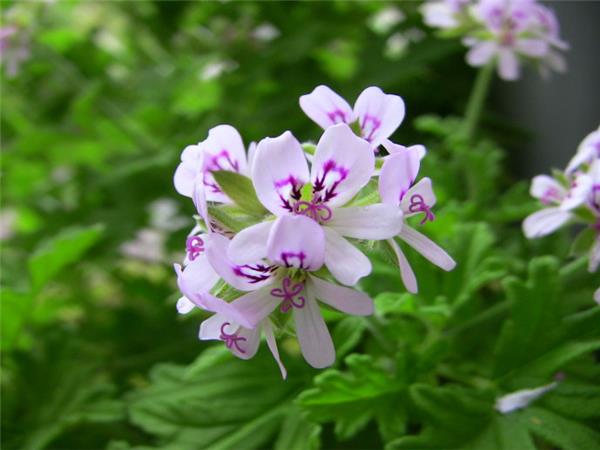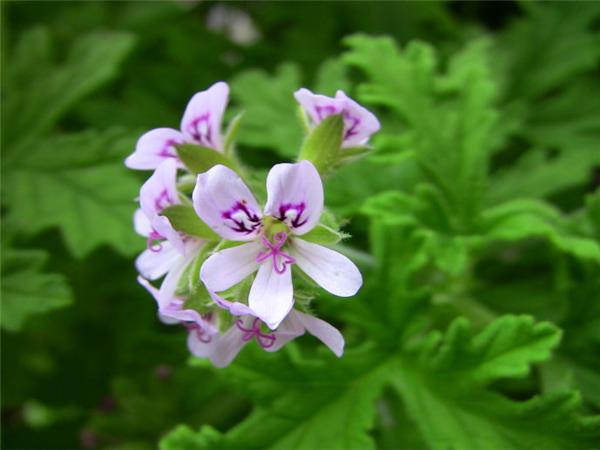Beautiful and fragrant mosquito repellent geranium
Incense leaf geranium not only has high ornamental value, but also can be used as traditional Chinese medicine to treat rheumatism and other diseases. The essential oil of incense leaf geranium also has the effect of beauty and skin care. In addition, it can also repel mosquitoes.

Efficacy and function of Pelargonium
As a curative effect of traditional Chinese medicine. This kind of plant is a kind of flower with pungent taste and warm nature. its main efficacy and function is to dispel wind and dehumidification, relieve pain and relieve pain, as well as insecticidal effect. it has a good effect on the treatment of rheumatic arthralgia, hernia, scrotal eczema and scabies. The usage and dosage above, not only can be taken internally in soup, but also can be used to soak wine, while for external use, it needs to be washed or smashed with an appropriate amount of fried water, which is recorded in Chinese Materia Medica.
For the skin and body. As many friends may know, geranium can make essential oils and cosmetics. In fact, it can also balance skin secretion and has a good effect on eczema, burns, herpes zoster and frostbite. Pale and inactive skin becomes ruddy and energetic after using geranium, and it can also regulate the body's hormone secretion and improve premenstrual syndrome and menopause. At the same time, it can also strengthen the function of the lymphatic system, remove toxins and increase immunity.

Matters needing attention in the Culture of Pelargonium
Habits: originally from the Cape of good Hope in southern Africa. Evergreen perennial herb, flowering and fruiting from March to June. The geranium prefers a warm and sunny environment. Not resistant to cold, avoid stagnant water and high temperature, resistant to barren, slightly resistant to shade. The suitable temperature for growth is 10 to 20 degrees, and the winter temperature is not less than 7 degrees. The summer is in a semi-dormant state, and the moisture is strictly controlled. The soil uses sandy loam with rich organic matter and good drainage. The suitable range for planting is below 1800 meters above sea level and less than 10 days during the frost period.
Reproduction: sowing and reproduction is carried out in March, indoor pot sowing, sowing soil with a mixture of high-temperature sterilized peat, culture soil and river sand, covering shallow soil after sowing; germination temperature is 13 to 18 degrees and germinates 1 to 3 weeks after sowing. The cuttings are propagated in April or September. The shoots of the same year are cut off or cut off by changing pots. The shoots are 7 to 8 centimeters long (3 to 4 knots), leaving the upper 1 or 2 leaflets to dry in semi-shade, and then inserted into the sand bed to take root for about 3 weeks.

Soil: Sandy loam rich in humus should be selected for soil cultivation. Pot culture can use a mixed matrix made of rotten leaves, coarse sand and garden soil, and their ratio is 1 by volume, 1.5 by volume. It is best to mix a small amount of bone meal at the same time, and its dosage can be controlled at about 0.3% of the total volume of the culture substrate.
Water and fertilizer: under normal circumstances, water should be watered once a week, and the supply of water should be ensured in the period of vigorous growth. It has a large demand for fertilizer, in addition to the application of base fertilizer at the time of planting, it can be topdressing every half a month in the stage of vigorous growth. In the high temperature season, the leaves of Pelargonium fragrans are easy to yellowing, shedding, growth stagnant and entering semi-dormant state. Watering should be reduced and should be watered in the early morning. If you find a few leaves yellowing in winter, you should stop applying fertilizer.
Lighting: Pelargonium geraniums like the environment where there is plenty of sunlight, so the plant has a stronger aroma and requires the plant to receive no less than 4 hours of direct sunlight every day.
Temperature: it likes warmth and is afraid of cold. It grows well in the temperature range of 22-30 ℃ and can withstand low temperature of 0 ℃.

The whole plant of Pelargonium fragrans has a strong aroma, so it is deeply loved by growers. It is used to decorate the courtyard or potted plants, and its fragrance effect on the environment is very obvious.
Related
- Wuhan Hospital Iron Tree Blooming Result Was Instantly Frightened by the Gardener Master
- Which variety of camellia is the most fragrant and best? Which one do you like best?
- What is the small blue coat, the breeding methods and matters needing attention of the succulent plant
- Dormancy time and maintenance management of succulent plants during dormancy
- Minas succulent how to raise, Minas succulent plant pictures
- What are the varieties of winter succulent plants
- How to raise succulent plants in twelve rolls? let's take a look at some experience of breeding twelve rolls.
- Attention should be paid to water control for succulent plants during dormant period (winter and summer)
- Watering experience of twelve rolls of succulent plants
- Techniques for fertilizing succulent plants. An article will let you know how to fertilize succulent plants.



